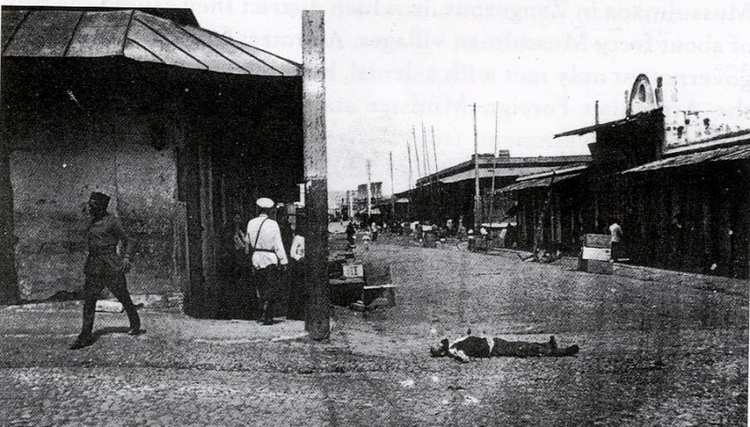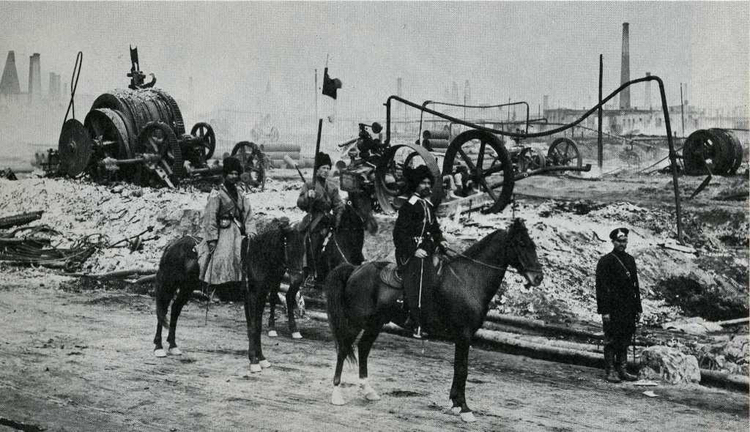Massacres of 1905
In 1905, Armenians perpetrated massacres in different parts of Transcaucasia, icluding Baku. Confrontations that were taking place in Russia itself and the strengthening of waves of dissatisfaction against the empire in Russia opened the way for the massacres. “Dashnaksutyun” and “Hunchak” political organizations had taken the responsibility of the leadership in Baku.
The Armenian Churches, including Armenian Saint Gregory the Illuminator Church in the center of Baku, were skillfully playing the role of the sources of financial and spiritual nourishment for Armenian chauvinism and Armenian nationalist parties at the beginning of 20th century. Because the law passed on June 12, 1903, about transferring church’s lands to the disposal of Russia’s Ministry of Land and Stock, had struck the financial situation of the organizations financed by the church. Terrorist groups of the Armenian political parties had organized revolts in protest against this law, had committed conflicts and terror in various cities of Transcaucasus, icluding Baku.

The killing of Agarza Babayev, resident of Sabunchu village, by Armenian terrorists on February 26, 1905 gave an impetus to “Armenian-Muslim” massacres. Some authors claim, this was not a coincidence, but an occurrence planned by wealthy Armenians of the Caucasus. Armenians were convinced that they would achieve what they wanted with the help of Armenian millionaires in Baku, seize the Baku petrol, and then expel Muslims from the Transcaucasus by force of arms and create an Armenian state.
After the bloody incident on February 6, the first massacres in the city and surrounding settlements began. Azerbaijanis were fired fom the rooftops and windows belonging to Armenians. Houses, shops were vandalized and looted. Many factories in Baku were burned and destroyed. Authorities did not act to stop the bloodshed. Russian Senator Alexandr Kuzminsky, who investaged the reasons and result of the massacres in Baku, wrote: “During the first massacres in Baku on February 6-9, 232 people were killed, most of the organizers were Armenians”. The massacres, which resulted in death and injury of hundreds of people on both sides, were stopped on February 9.
Governer-General of Baku, prince Nakashidze openly stated that guilty of the disorders were Armenians, not Azerbaijanis. Just because of his position, the Dashnaktsutyun Party gave Nakashidze the death sentence. Nakashidze was warned about the decision.
On May 11, 1905 at 11 a.m., Governer-General of Baku, prince Michael Nakashidze was killed by a bomb thrown by Armenians near the Armenian church – in the crossing of the Pharaphet garden (currently Fountain square) and Vorontsov street (currently Mirza Ibrahimov). Nakashidze is seriously injured and died on May 18. During the terroristic act , Nakashidze’s aide-de-camp and two Azerbaijanis , who were accidentelly there also were killed. The Central Committee of the Dashnaktsutyun Party has claimed responsibility for an explosion.

Explosives and bombs were produced at factories and plants belonging to Armenians for using in terroristic acts in Baku. After the killing of Nakashidze, the police made searches in the Armenian-owned enterprises in the city. On May 19, 1905 the police found out explosive missiles and 80 ready-made bombs in the Sarkis Pogosbekov’s metalworking workshop in the Telefonnaya street in Baku. Also, three more explosive bombs were discovered in the ditch of the workshop’s yard.
On August 20 of the same year, Armenians commited the second massacres in Baku. A few minutes after the beating of the Armenian church in the center of the city, Azerbaijanis were fired from houses and shops belonging to Armenians. For a short time the incidents were covered settlements in Baku surroundings and oil fileds. The massacres ceased on August 30 thanks to serious measures taken by the authorities. During the second massacre, about 500 people were killed on both sides, and two-thirds were Muslim-Turks.
On August 23-25, terrible fires in oil fields and factories in Baku were the reasons for thousands of peopel to loose their jobs.
On September 10, 1905 General Governor of Caucasus Vorontsov-Dashkov arrived in Baku to conclude a truce between Armenians and Azerbaijanis. On September 14, more than thousand Armenians and Azerbaijanis, headed by progressive intellectuals and priests, gathered on Dunskaya square in Baku. Here the guberniya gadi (judge of a Sharia court) Mir Mehemmed Kerim aga Mirjafarzade, the Armenian priest and the Provisional Governor-General S. Fadeyev addressing to the people, called everyone for peace. A special comission was created from the reperesentatives of both sides for carrying negotiations, but the tranquility didn’t last long.
The third massacres in Baku was realized on October 20-25, 1905. Two days after the signing of October Manifesto, the Dashnaktsutyun Party had organized rallies in the center of Baku for releasing five Armenian prisoners who killed Nakashidze. An armed clashes between Armenians and Muslims have occurred in Nizami (formerly Torgovaya) street. Azerbaijanis were fired from Armenian houses and shops again. Angry Muslims made counterattack. More than 20 Armenians houses, which became arsenals were burnt. The riots continued in Bayil settlement and oil fields. The massacres were stopped thanks to the acute intervention of power structures. During the period more than 60 people were killed in the city and 35 in Bayil settlement.
According to Armenian researcher A. Lalayan, the Caucasus janishin (vicar) Illarion Vorontsov-Dashkov’s wife Elizaveta Grigorevna was a mistress of Mesrop, one of the leaders of Tbilisi bureau of the Dashnaksutyun Party. Issues of the Caucasus Viceroyalty serving Armenian interests were adopted in the bedroom of vicar. Armenian millionaires gave an oil deposit in Balakhani as a present to Vorontsov-Dashkov for his service. A photo is avialable in Photogallery.
Armenians terminated to realize their terrorist acts temporarily as Azerbaijanis established Difai party in the autumn of 1906. Tranquility in the city was secured until March, 1918.
